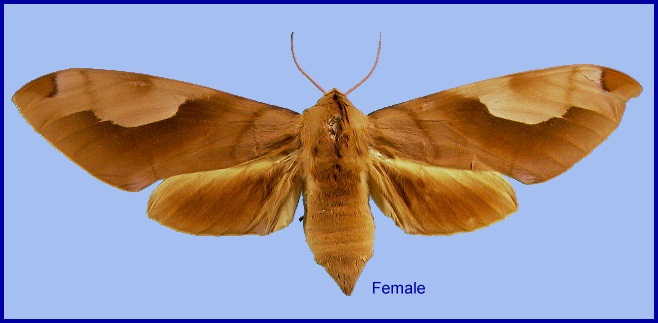
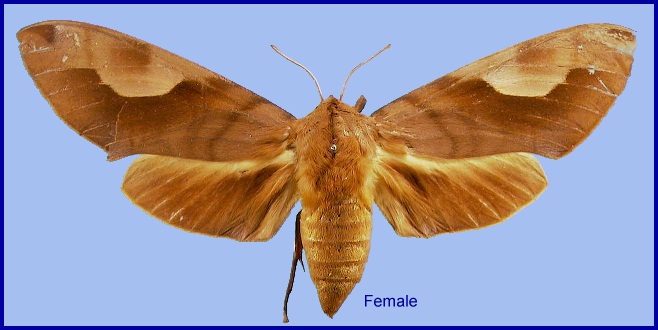

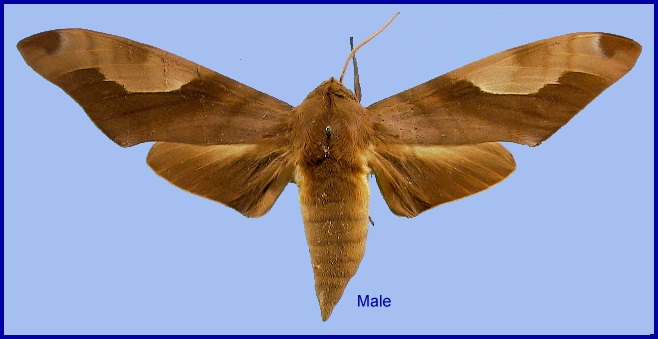
Clanis titan Rothschild & Jordan, 1903, Novit. zool. 9 (suppl.): 213 (key), 218. Type locality: [India, Meghalaya,] Khasia Hills [Khasi Hills].
Wingspan: 128--148mm. Mid- and hind tibiae white above (in Clanis phalaris the mid-tibia not white), the latter as long as male or female -- 1 mm. longer than first tarsal segment. Short tibial spurs barely one-third of the long ones, little longer than the tibia is broad. Scaling of antenna pale pink; frons and end of palpus very little darker than sides of occiput. Forewing distal margin about 1 mm shorter than internal one in male, 7mm in female; chestnut, paler and somewhat pinkish towards base, a large vinaceous-cinnamon patch expanded between costal margin and M3, extended to distal margin between R5 and M1, not between R5 and M2 as in Clanis phalaris. The forewing transverse lines not dentate; a broad subbasal line about 5 mm from base of Cu2 , distinct, another almost parallel with it a little distal of Cu2, indistinct, some traces of lines between this and internal angle; within the pale area a large brown patch or cloud, representing two lines, situated upon the subcostal fork; another line between this cloud and the apical patch. Hindwing upperside as in Clanis phalaris, but the basal area darker chestnut. Underside as in Clanis phalaris, the transverse lines of forewing less distinct; middle line of hind wing close to proximal line, the interspace partly filled up with scaling of the same colour as the lines (Bell & Scott, 1937). They also noted that bred moths which emerged soon after pupation were paler in colour than those which emerged after a long period. Dry season/region forms are much redder and paler than wet season/region forms.

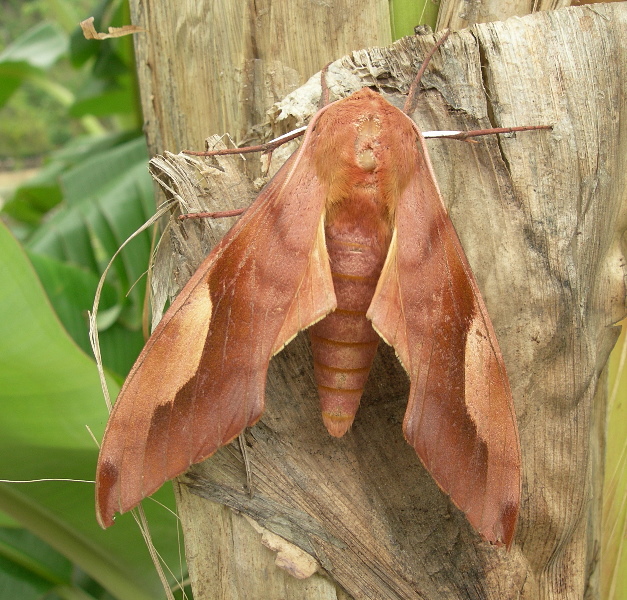
China: v (Guangdong); vi (Yunnan; Guizhou); 8.viii (Yunnan).
OVUM: Initially bright transluscent yellow, oval, 1.5-2.0mm in diameter. As the larvae form inside the tranluscence become an opague custard yellow (Greg Watson, pers. comm. 2012).
LARVA: Full-fed 110mm; width 15mm; horn 1mm. Neonate larvae are uniformly yellow with the horn black (Greg Watson, pers. comm. 2012). According to Bell & Scott (1937), in the final instar, the head large and deep, broadly semi-elliptical in shape. True clypeus less than one-third length of head, basal angles tumid; false clypeus showing as a narrow strip near basal angles of true clypeus, widening upwards, apex acute. Labrum one-quarter length of clypeus, not as broad as clypeus; ligula longer than labrum but not so broad, kidney-shaped. Surface of head moderately shiny, superficially, coarsely corrugate and set with small, hemispherical, shiny, setiferous tubercles, and scattered with still smaller tubercles. Clypeus coarsely, transversely corrugate. Body stout and nearly cylindrical. Horn a conical tubercle about 1mm long. Surface of body dull with a transverse row of small tubercles around each secondary ring. There is a transverse row of larger tubercles around the front margin of segment 2, and a subdorsal and a subspiracular stripe formed of large tubercles on 2 to 5, the latter joining the lower end of the oblique lateral stripe on 5. The oblique lateral stripes formed of large tubercles on segments 5 to 11, each running back to near the dorsal line, that on 11 running across 12 to base of horn, and formed of larger tubercles than the rest. There are larger tubercles on the horn, anal flap and claspers.
In colour, head glaucous bluish-green, the tubercles whitish. Labrum and ligula classy-white; antenna whitish; mandible pale pink, the tip shortly black. Body pale green or dark yellowish-green, the smell tubercles white, the large ones forming the lateral stripes yellow; those on anal flap and claspers rose-coloured. Horn green; true legs pink, the outer sides dark brown; prolegs and claspers green; venter glaucous green. Spiracles broadly oval, bluish-green with a narrow oval depressed, central longitudinal area green (Bell & Scott, 1937).
PUPA: 68mm; width 18 mm. Mainly chestnut in colour, the tumidities at the front margins of the abdominal segments, spiracles and cremaster black. Surface shiny, head smooth, segment 2 and wing cases superficially, transversely, coarsely corrugate. Segment 4 smooth; front margins of 5 to 12 slightly tumid and coarsely pitted except on venter. Ante-spiracular ridges on 9 to 11 in the form of six narrow, parallel ridges, separated by channels. Spiracle of 2 covered by a short, rounded lobe, sunken behind raised in front, projecting from the front margin of 3 into a corresponding concave emargination of the hind margin of 2, the whole dull and minutely shagreened. The remaining spiracles narrowly oval, flat, rased, with a narrow, shiny rim. Cremaster wedge-shaped, short, surface very coarsely rugose and ending in a narrow, shiny, longitudinal ridge (Bell & Scott, 1937).
The larva may change to a pupa after a month or so, but frequently diapauses underground as a pre-pupal larva for eight months or more. It may even come to the surface again and pupate there. The pupa, if touched, wiggles and makes a slight hissing noise (? by rubbing the ante-spiracular ridges against an opposing surface).
Larval hostplants. Pterocarpus marsupium in India (Bell & Scott, 1937). In Laos and Thailand, recorded from Dalbergia olivieri (Eitschberger & Ihle, 2010).
China: Yunnan (Laojun Shan, 2579m; Xishuangbanna; Ruili); Guizhou (Xinzhaidashan, Zhijin County, 1000-2000m); Guangdong (Dianhu Shan; Songshuwo, north of Zhaoqing).
From India (Pathania, Sunita Sharma & Gill, 2014; Subhasish Arandhara, 2016 & 2017), Nepal and Bhutan (Irungbam & Irungbam, 2019) east and south through Burma/Myanmar and southwestern China (Yunnan to Guangdong) to Thailand, Vietnam and Peninsular Malaysia. Records from Sumatra, Indonesia, are of a related species.
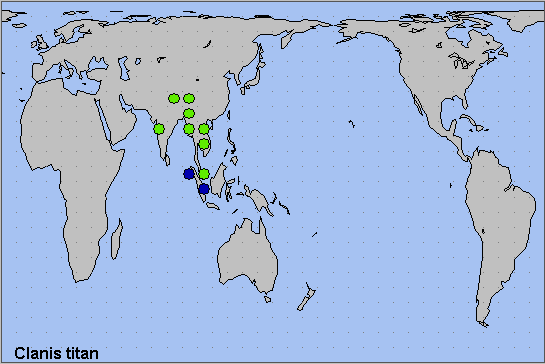
 Return to Sphingidae of the Eastern Palaearctic species list
Return to Sphingidae of the Eastern Palaearctic species list